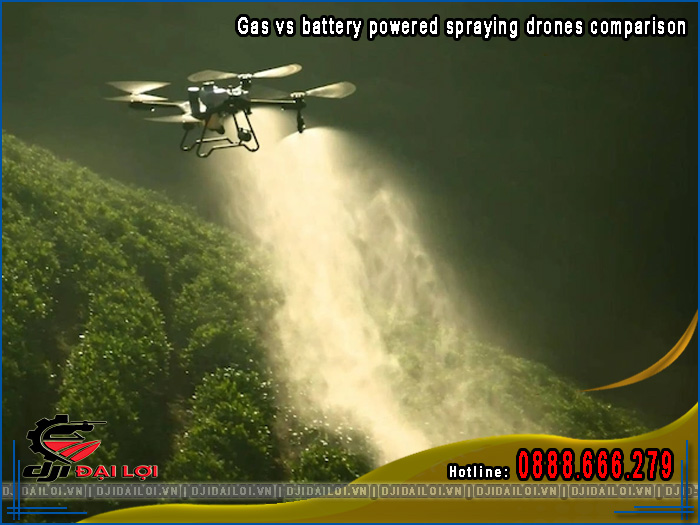In recent years, agricultural spraying drones have become a modern alternative to manual labor in crop protection. From small farms to large-scale operations, unmanned aerial technology has significantly boosted efficiency and reduced chemical exposure. However, many farmers and investors struggle when choosing between gasoline-powered spraying drones and battery-based models.
This isn’t just about selecting a piece of equipment - it ties into your farming model, available budget, maintenance capacity, and geographic conditions. A detailed comparison is essential to understand the decisive factors and make the right investment.

To conduct a fair and practical comparison, we use core criteria that directly impact performance and cost-effectiveness. These benchmarks are commonly recommended by agricultural engineers and drone specialists:
These criteria reflect not only technical specifications but also real-world user experience.
If you've ever stood in a field mid-season, relying on uninterrupted operation, you'll understand why the "gas vs battery" question matters. Let’s explore the technical and financial details.
|
Criteria |
Gasoline Drone |
Battery Drone |
|---|---|---|
|
Fuel / Energy |
~25,000–30,000 VND/liter of A92 fuel |
220V charging: ~2,000–3,000 VND/charge |
|
Maintenance |
Regular service: spark plugs, filters, oil |
Battery replacement after ~300 cycles (6–12 months) |
|
Component Lifespan |
3–5 years if maintained well |
Battery typically lasts 1–1.5 years |
|
2-Year Total Cost |
~90–120 million VND (fuel + maintenance) |
~120–140 million VND (battery + charger costs) |
While fuel seems more expensive at first glance, battery-powered drones can become costlier in the long run due to battery lifecycle and infrastructure needs.
Choosing a spraying drone is more than a technical decision - it involves safety, usability, and environmental factors.
There’s no one-size-fits-all answer. Your decision depends on your farm scale, location, investment level, and technical capability. Here are practical scenarios:
If unsure, start with a compact battery drone (7–10L) and consider upgrading to gasoline once usage frequency increases.
Understanding both the investment and legal framework is crucial for proper, compliant use.
|
Item |
Gasoline Drone |
Battery Drone |
|---|---|---|
|
Base Price (10–20L) |
~120–160 million VND |
~100–130 million VND |
|
Essential Accessories |
Fuel tank, filters, spare parts |
2–3 spare batteries, fast charger |
|
Total Initial Cost |
~150–180 million VND |
~130–160 million VND |
While gasoline drones cost more upfront, their performance may shorten ROI periods with regular use.
Under Circular 19/2019/TT-BGTVT and Decision 18/2021/QĐ-TTg, all agricultural drones must:
Some provinces (e.g., Lâm Đồng, Tiền Giang) ban unauthorized drone spraying due to airspace safety risks.
Always buy from authorized dealers (DJI, Yamaha, SunDrone) for legal paperwork, training, and safety guidance.
Even with all the data, real-life use can present unique challenges. Consider these special scenarios:
Small 10–12L battery drones with semi-auto mode for precision and maneuverability
Battery drones with solar charging at fixed points; IP67-rated models recommended
Use service providers with high-capacity gasoline drones - saves time and avoids technical risks
Only gasoline drones support high payload rotary spreaders; battery models lack endurance for this mode
Battery drones with low noise motors; spray early morning or late afternoon to minimize disruption
|
Component |
Gasoline Drone |
Battery Drone |
|---|---|---|
|
Engine |
Service every 30–50 flight hours |
N/A (just monitor ESCs) |
|
Battery |
N/A |
Store at 50%, avoid overcharging if unused |
|
Sprayer |
Clean after every use |
Same for both types |
|
Long-Term Storage |
Drain fuel, store dry |
Store battery at 50%, avoid heat/light |
No matter your choice, drone handling skills and technical knowledge are vital to maximize device lifespan and cut costs.
Gasoline-powered spraying drones clearly excel in performance and field endurance - ideal for large farms or areas with no electricity. In contrast, battery-powered drones are better for beginners, small farms, or eco-regulated operations.
Choose based on your farm size, budget, and regional infrastructure to achieve optimal results. If unsure, start with a compact battery drone or rent a service before making a major investment.